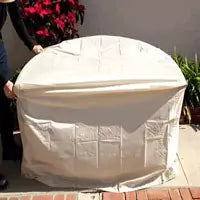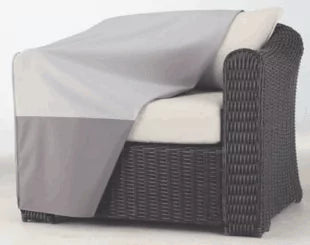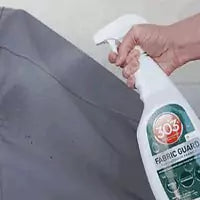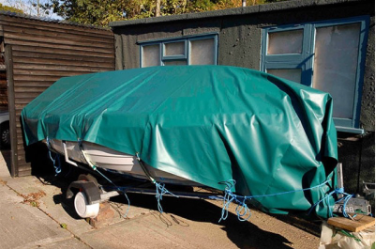Comprehensive Guide: How to Get Couch Covers to Stay in Place

The Importance of a Secure Couch Cover
Enhancing the Aesthetics and Functionality of Your Living Space

Are you tired of constantly readjusting your couch covers? Do they slip and slide whenever you sit down or get up from your sofa? We understand your frustration. Fortunately, there are several effective methods to get couch covers to stay in place, ensuring a neat and well-maintained appearance for your living room. In this article, we will explore some tried and tested techniques to help you keep your couch covers securely in position.
Preventing Unwanted Slipping and Sliding
Choose the Right Couch Cover
When it comes to getting couch covers to stay in place, selecting the right type of cover is crucial. Look for slipcovers specifically designed to offer a snug fit and prevent excessive movement. Sure Fit couch covers, for instance, are renowned for their quality and ability to stay in place. These covers are tailored to fit different couch sizes and styles, providing a seamless look while ensuring maximum stability.
Finding the Right Fit for Maximum Stability
To ensure a perfect fit, it's important to measure your couch accurately before purchasing a cover. Take measurements of the length, width, and height of your sofa, and compare them with the dimensions provided by the manufacturer. This will help you select the right size of couch cover that will stay in place without any unnecessary shifting or sagging.
Selecting Slipcovers Designed for Snugness and Durability
When it comes to getting your couch covers to stay in place, one of the most important factors to consider is finding the right fit. A properly fitting slipcover is essential for achieving maximum stability and preventing unwanted shifting or slipping. In this section, we will explore the importance of selecting slipcovers designed for snugness and durability, ensuring a secure and long-lasting solution for your couch.
When searching for a slipcover, prioritize options that are specifically designed to provide a snug fit. These slipcovers are tailored to match the contours and dimensions of your couch, creating a seamless and custom look. A snug-fitting cover will not only enhance the aesthetics of your living space but also significantly improve its functionality by staying in place even during active use.
Durability is another crucial aspect to consider when selecting slipcovers. Look for materials that are known for their strength and longevity. Fabrics such as canvas, denim, or twill are often favored for their durability and ability to withstand everyday wear and tear. Reinforced stitching and quality craftsmanship are indicators of a slipcover's durability, ensuring that it will hold up well over time.
Consider the type of fabric that best suits your needs. If you have pets or children, choosing a slipcover that is resistant to stains or easy to clean might be a wise decision. Some slipcovers come with additional features like water resistance or pet hair repellency, making maintenance and cleaning a breeze. By selecting a slipcover that is both snug and durable, you can enjoy a long-lasting solution that provides the stability you desire.
It is crucial to pay attention to the specific measurements and dimensions recommended by the slipcover manufacturer. Take accurate measurements of your couch, including the length, width, and height. Compare these measurements with the product specifications provided to ensure a proper fit. Avoid the temptation to guess or estimate, as an ill-fitting slipcover can lead to constant readjustments and frustration.
If your couch has unique features such as curved arms or oversized cushions, look for slipcovers that are designed to accommodate those characteristics. Many slipcover manufacturers offer options for various couch styles and sizes. Taking the time to find a slipcover that matches the specific design of your couch will greatly contribute to its overall stability and appearance.
When shopping for slipcovers, take advantage of customer reviews and ratings. Read about the experiences of others who have purchased the same slipcover to gain insights into its fit and durability. Pay attention to any comments regarding slipping or sliding issues. This information can help you make an informed decision and choose a slipcover that has a track record of staying in place.

Securing Your Couch Cover with Non-Slip Grippers
Creating Friction Between the Cover and Sofa Surface
When it comes to keeping your couch cover in place, non-slip grippers are an effective solution that can significantly enhance stability. These grippers are designed to create friction between the cover and the sofa surface, preventing unwanted slipping and sliding. In this section, we will explore how non-slip grippers work and provide tips for their proper placement and distribution to achieve optimal results.
Non-slip grippers are typically made of rubber or silicone material, which offers excellent grip and traction. The textured surface of these grippers helps to create friction, effectively anchoring the couch cover and preventing it from moving out of place. This added stability is especially beneficial for loose-fitting slipcovers or materials that have a tendency to slide easily.
Placement and Distribution for Optimal Results
To make the most of non-slip grippers, proper placement is essential. Start by determining the areas of the couch that are prone to slipping. These are typically the seat cushions, backrests, and armrests. Carefully lift the cover and place the grippers between the cover and the sofa surface in these specific areas. The grippers should be evenly distributed to ensure a balanced hold and prevent any lopsidedness.
Pay close attention to the edges of the couch cover, as they are more likely to shift. Place the non-slip grippers along the edges, making sure they extend to the sides of the couch. This will provide additional reinforcement and stability, preventing the cover from bunching up or sliding off.
For loose-fitting slipcovers, it may be necessary to use more grippers to achieve a secure hold. Consider placing grippers not only on the seat cushions but also in between the cushions and the armrests or backrests. This will help to maintain the overall alignment of the cover and minimize any excess fabric movement.
In addition to the placement, the distribution of non-slip grippers is equally important. Ensure that the grippers cover a sufficient surface area to provide a strong and consistent grip. Avoid clustering all the grippers in one spot, as this may create uneven tension and cause the cover to wrinkle or bunch up in certain areas.
If you are using a slipcover with separate cushion covers, it is advisable to place non-slip grippers underneath each cushion cover as well. This will help to secure the individual cushions in place, preventing them from shifting and maintaining a neat and uniform appearance.
Regularly inspect the grip of the non-slip grippers and readjust them if necessary. Over time, the grip may weaken due to friction or movement. Take the opportunity to reposition the grippers and ensure they are still providing optimal stability for your couch cover.
Finding the Right Fit for Maximum Stability
Selecting Slipcovers Designed for Snugness and Durability
When it comes to keeping your couch covers in place, selecting the perfect cover is the first step towards achieving maximum stability. A well-fitted cover not only enhances the appearance of your couch but also ensures that it stays securely in place. In this section, we will explore the importance of selecting slipcovers designed for snugness and durability, as well as considerations for style and dimensions.
Selecting slipcovers that are designed for snugness and durability is crucial in ensuring that your couch cover stays in place. Look for slipcovers that are specifically tailored to fit your couch's dimensions. These slipcovers are usually made from stretchable fabrics or incorporate elasticized edges, allowing them to conform tightly to the contours of your couch. The snug fit not only prevents the cover from shifting but also helps to minimize wrinkles and unsightly bunching, giving your couch a clean and polished look.
Durability is another important factor to consider when choosing the perfect couch cover. Opt for slipcovers made from high-quality materials that are known for their strength and longevity. Fabrics such as canvas, denim, or twill are popular choices due to their durability and ability to withstand everyday wear and tear. Additionally, look for slipcovers with reinforced stitching and well-crafted seams, as these features contribute to the overall durability of the cover. A durable slipcover will not only stay in place but also withstand the test of time, maintaining its appearance and functionality for years to come.
Considerations for Style and Dimensions
Considerations for style and dimensions are also crucial when selecting a couch cover. The style of the slipcover should harmonize with your existing decor and personal preferences. Whether you prefer a sleek and modern look or a cozy and traditional feel, there are slipcover options available to match your desired style. Choose a color or pattern that complements your overall interior design, adding a touch of elegance or a pop of personality to your living space.
When it comes to dimensions, accurate measurements are key. Each slipcover manufacturer provides size guidelines that include measurements for different types and styles of couches. Take precise measurements of your couch, including the length, width, and height, and compare them with the manufacturer's specifications. Avoid making assumptions or estimations, as an ill-fitting cover may not only look unappealing but also have a higher chance of slipping or coming loose. Investing time in finding a slipcover that matches the specific dimensions of your couch will ensure a proper fit and enhance both the stability and aesthetics of the cover.
If your couch has unique features, such as curved arms or oversized cushions, look for slipcovers designed to accommodate these characteristics. Many slipcover manufacturers offer options tailored to different couch styles and sizes. Choosing a cover that considers the unique design elements of your couch will not only provide a secure fit but also enhance the overall stability and appearance of the cover.
Achieving a Customizable and Firm Hold
Attaching Velcro Strips to the Cover and Sofa Surface
When it comes to keeping your couch cover securely in place, harnessing the power of Velcro strips can provide a customizable and firm hold. Velcro strips are a versatile solution that offers convenience and ease of use. In this section, we will explore how to effectively use Velcro strips to keep your couch cover in place, including attaching the strips to the cover and sofa surface, as well as ensuring proper placement and adjustment for balanced tension.
Velcro strips consist of two components: the hook side and the loop side. The hook side has small, stiff hooks, while the loop side has soft, fuzzy loops. To attach Velcro strips to your couch cover, carefully sew or stick the loop side of the strips to the inside of the cover, ensuring that they are evenly spaced and securely fastened. The loop side will act as the base for attaching the hook side, creating a firm and adjustable hold.
Next, attach the hook side of the Velcro strips to the sofa surface. Clean the surface of the sofa to ensure optimal adhesion. Stick the hook side strips to the desired areas, making sure they align with the loop side strips on the cover. The hook side will firmly attach to the loop side, creating a strong grip and preventing the cover from slipping or sliding.
Proper Placement and Adjustment for Balanced Tension
Proper placement and adjustment of the Velcro strips are crucial for achieving balanced tension and a secure hold. Start by strategically placing the strips on areas of the couch cover that are prone to movement, such as the seat cushions, backrests, and armrests. Ensure that the strips cover a sufficient surface area to distribute the tension evenly and prevent any lopsidedness.
As you attach the hook side strips to the sofa surface, pay attention to the alignment with the loop side strips on the cover. Make any necessary adjustments to ensure that the strips properly connect and create a firm grip. Take care not to attach the strips too tightly, as this may cause unnecessary strain on the fabric or distort the shape of the cover. Finding the right balance of tension is key to achieving a secure hold without compromising the comfort or appearance of your couch.
Regularly check and readjust the Velcro strips as needed. Over time, the tension may loosen or the strips may shift due to movement or usage. Take the opportunity to reposition the strips and ensure they are still providing a firm and balanced hold.
Ensuring Stability with Elastic Straps
Securing Straps to the Bottom or Corners of the Sofa
When it comes to achieving stability for your couch cover, elastic straps are a reliable option. These straps provide a secure hold and prevent the cover from slipping or moving out of place. In this section, we will explore how to effectively use elastic straps to keep your couch cover stable, including securing the straps to the bottom or corners of the sofa and adjusting the tension for a snug fit.
Elastic straps are designed to be flexible and stretchable, making them ideal for securing couch covers. Begin by attaching the straps to the bottom or corners of the sofa. Depending on the design of your couch, you may have the option to attach the straps either underneath the sofa or to the corners of the frame. Look for elastic straps that come with hooks or clips for easy attachment.
For straps that attach underneath the sofa, carefully thread the straps through the frame or between the seat cushions, ensuring that they are evenly distributed. If the straps come with hooks, secure them to the frame or any available anchor points underneath the sofa. This will anchor the cover and prevent it from shifting.
If your couch has removable cushions, you can also secure the elastic straps to the corners of the cushions. Attach the hooks or clips of the straps to the corners of the cushions and then reposition the cushions back onto the couch. This method provides stability by securing the cover through the cushion corners, keeping it in place even during frequent use.
Adjusting Tension for a Snug Fit
After attaching the elastic straps, adjust the tension to achieve a snug fit. The straps should be stretched enough to hold the cover firmly in place, but not so tight that they cause distortion or discomfort. Test the tension by sitting on the couch and observing if the cover remains secure. If necessary, make slight adjustments to the strap length or position to achieve the desired level of tension.
Regularly check the straps for any signs of wear or loosening. Over time, the elasticity of the straps may reduce, or the hooks or clips may become less secure. Replace any worn-out straps and ensure that the hooks or clips are properly attached to maintain the stability of your couch cover.
Adding Extra Grip and Security
Placing Anti-Slip Underlays on Seat Cushions or Sofa Base
When it comes to keeping your couch cover securely in place, harnessing the power of anti-slip underlays can provide you with extra grip and security. These underlays are designed to prevent slippage and enhance stability, ensuring that your couch cover stays exactly where you want it. In this section, we will explore how to effectively use anti-slip underlays to keep your couch cover in place, including placing the underlays on seat cushions or the sofa base, as well as their role in enhancing stability and preventing slippage.
Anti-slip underlays are made from materials that have a non-slip surface, such as rubber or silicone. These materials create friction between the couch cover and the seat cushions or the sofa base, providing an extra layer of grip and security. To use anti-slip underlays, simply place them on the seat cushions or the sofa base before adding the couch cover.
To place the underlays on the seat cushions, remove the cover if applicable and position the underlay on top of the cushion. Make sure the underlay covers the entire surface area of the cushion and lies flat. Then, place the couch cover back over the cushion, ensuring that the underlay is sandwiched between the cushion and the cover. The anti-slip underlay will create a firm grip, preventing the cover from slipping or sliding.
Enhancing Stability and Preventing Slippage
If your couch has a non-removable cushion or you want to enhance stability at the sofa base, place the anti-slip underlay directly on the sofa base before adding the cover. Position the underlay to cover the desired area where the cover tends to move or shift. Once the underlay is in place, carefully position the couch cover over the underlay, ensuring that it adheres to the non-slip surface.
The anti-slip underlays enhance stability and prevent slippage by increasing the friction between the couch cover and the seat cushions or the sofa base. The non-slip surface of the underlay holds the cover in place, minimizing any movement or shifting that may occur during use. This is especially beneficial if you have active households or if you frequently entertain guests, as it ensures that your couch cover remains neatly arranged.
It is important to note that anti-slip underlays can be easily removed and repositioned if necessary. This allows you to readjust them or clean them as needed, ensuring their effectiveness over time.
Regular Maintenance for a Lasting Solution
Periodically Inspecting and Readjusting the Couch Cover
To ensure that your couch cover stays in place over the long term, it's important to engage in regular maintenance and periodically double-check and reevaluate its positioning. By implementing this approach, you can enjoy a lasting solution that keeps your couch cover secure and maintains a neat and well-fitted appearance. In this section, we will explore the significance of regular maintenance, including periodically inspecting and readjusting the couch cover, as well as the benefits of maintaining a neat and well-fitted appearance.
Regular maintenance is key to a lasting solution for keeping your couch cover in place. It's important to periodically inspect the cover and evaluate its positioning. Over time, the cover may shift or loosen due to regular use, pets, or other factors. By taking the time to inspect the cover, you can identify any areas that require readjustment or additional support.

Maintaining a Neat and Well-Fitted Appearance
Periodically readjusting the couch cover ensures that it remains securely in place. Check for any signs of slipping, bunching, or loose areas. Smooth out any wrinkles or creases and reposition the cover as needed. This step helps to maintain the overall stability and appearance of the cover, ensuring that it looks tidy and well-fitted.
In addition to inspecting and readjusting the cover, it's crucial to maintain a neat and well-fitted appearance. A properly fitted cover not only enhances the aesthetics of your couch but also helps to prevent slipping and shifting. Smooth out any wrinkles or excess fabric, ensuring that the cover fits snugly over the couch. Tuck in any loose areas or use additional securing methods like Velcro strips, elastic straps, or anti-slip underlays for added stability. This attention to detail contributes to a visually appealing and well-maintained couch cover.
Regular maintenance also provides an opportunity to clean the cover and address any spills or stains promptly. Follow the manufacturer's instructions for cleaning the cover, whether it requires machine washing, hand washing, or spot cleaning. Maintaining a clean cover not only contributes to its longevity but also enhances its overall appearance and freshness.
By double-checking and reevaluating the positioning of your couch cover, as well as maintaining a neat and well-fitted appearance, you can ensure its longevity and stability. Regular maintenance allows you to address any shifting or loosening of the cover promptly, minimizing the risk of slipping or sliding. It also contributes to a visually pleasing and well-maintained couch cover that adds charm and elegance to your living space.
Achieving Couch Cover Perfection
Transforming Your Living Room into a Stylish and Secure Space
Maintaining a neatly arranged couch with a securely fitted cover is now within your reach. By following the tips and tricks outlined in this article, you can say goodbye to the frustration of constantly adjusting your couch covers. Whether you choose non-slip grippers, tucking, Velcro strips, elastic straps, or anti-slip underlays, each method offers an effective solution to get your couch covers to stay in place.
Enjoying the Benefits of a Neat and Well-Maintained Sofa
Remember to measure your couch accurately and choose the right type of cover, such as a Sure Fit couch cover, for optimal results. By implementing these techniques, you can transform your living room into a comfortable and stylish space with couch covers that stay perfectly in place.
0 comments


